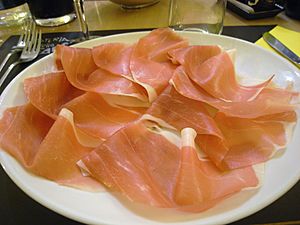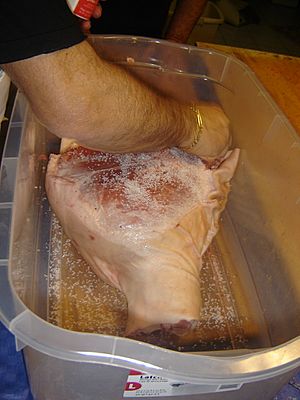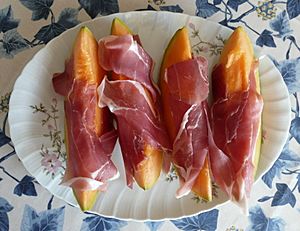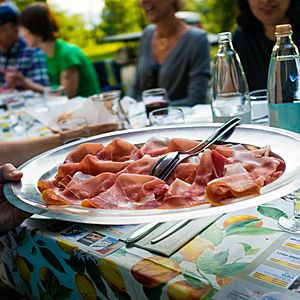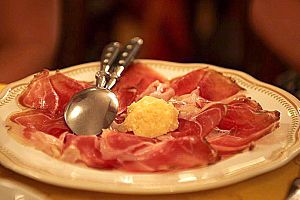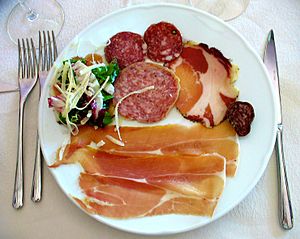Prosciutto facts for kids
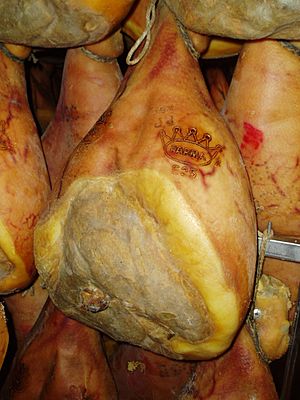
Prosciutto di Parma PDO
|
|
| Course | Antipasto |
|---|---|
| Place of origin | Italy |
| Similar dishes | Jamón serrano |
Prosciutto crudo, in English often shortened to prosciutto (/prəˈʃuːtoʊ, proʊˈ-/ PRƏ-shoo-TOH-,_-PROH--, Italian: [proʃˈʃutto]), is Italian uncooked, unsmoked, and dry-cured ham. Prosciutto crudo is usually served thinly sliced.
Several regions in Italy have their own variations of prosciutto crudo, each with degrees of protected status, but the most prized are Prosciutto di Parma PDO from Emilia-Romagna and Prosciutto di San Daniele PDO from Friuli Venezia Giulia. Unlike Speck (Speck Alto Adige PGI) from the South Tyrol region, prosciutto is not smoked.
In Italian, prosciutto means any kind of ham, either dry-cured (prosciutto crudo or simply crudo) or cooked (prosciutto cotto), but in English-speaking countries, it usually means either Italian prosciutto crudo or similar hams made elsewhere. However, the word "prosciutto" itself is not protected; cooked ham may legally be, and in practice is, sold as prosciutto (usually as prosciutto cotto, and from Italy or made in the Italian style) in English-speaking regions.
Contents
Etymology
The word prosciutto derives in turn from Italian asciutto ("dry"), with prefix substitution, or from Vulgar Latin pro (before) + exsuctus (past participle of exsugere "to suck out [the moisture]"); the Portuguese presunto has the same etymology. It is similar to the modern Italian verb prosciugare "to dry thoroughly" (from Latin pro + exsucare "to extract the juices from").
Manufacture
Prosciutto is made from either a pig's or a wild boar's hind leg or thigh, and the base term prosciutto specifically refers to this product. Prosciutto may also be made using the hind leg of other animals, in which case the name of the animal is included in the name of the product, for example "prosciutto cotto d'agnello" ("lamb prosciutto"). The process of making prosciutto can take from nine months to two years, depending on the size of the ham.
A writer on Italian food, Bill Buford, describes talking to an old Italian butcher who says:
When I was young, there was one kind of prosciutto. It was made in the winter, by hand, and aged for two years. It was sweet when you smelled it. A profound perfume. Unmistakable. To age a prosciutto is a subtle business. If it's too warm, the aging process never begins. The meat spoils. If it's too dry, the meat is ruined. It needs to be damp but cool. The summer is too hot. In the winter—that's when you make salumi. Your prosciutto. Your soppressata. Your sausages.
Today, the ham is first cleaned, salted, and left for about two months. During this time, the ham is pressed, gradually and carefully so as to avoid breaking the bone, to drain all blood left in the meat. Next, it is washed several times to remove the salt, and is hung in a dark, well-ventilated environment. The surrounding air is important to the final quality of the ham; the best results are obtained in a cold climate. The ham is then left until dry. The time this takes varies, depending on the local climate and size of the ham. When the ham is completely dry, it is hung to air, either at room temperature or in a controlled environment, for up to 18 months.
Prosciutto is sometimes cured with nitrites (either sodium or potassium), which are generally used in other hams to produce the desired rosy color and unique flavor, but only sea salt is used in Protected Designation of Origin hams. Such rosy pigmentation is produced by a direct chemical reaction of nitric oxide with myoglobin to form nitrosomyoglobin, followed by concentration of the pigments due to drying. Bacteria convert the added nitrite or nitrate to nitric oxide.
Use
Sliced prosciutto crudo in Italian cuisine is often served as an antipasto, wrapped around grissini, or accompanied with melon or figs. It is also eaten as accompaniment to cooked spring vegetables, such as asparagus or peas. It may be included in a simple pasta sauce made with cream, or a Tuscan dish of tagliatelle and vegetables. It is used in stuffings for other meats, such as veal, as a wrap around veal or steak, in a filled bread, or as a pizza topping.
Saltimbocca is an Italian veal dish in which escalopes of veal are topped with a sage leaf before being wrapped in prosciutto and then pan-fried. Prosciutto is often served in sandwiches and panini, sometimes in a variation on the Caprese salad, with basil, tomato and fresh mozzarella.
European Union Protected Designations of Origin
Prosciutto crudo
Under the Common Agricultural Policy of the European Union (EU), certain well-established meat products, including some local prosciutto, are covered by a Protected Designation of Origin (PDO) – DOP in Italian – and other, less stringent designations of geographical origin for traditional specialties. Various regions have their own PDO, whose specifications do not in general require ham from free-range pigs. The simple Italian description prosciutto, used alone or with crudo or cotto is not in itself a protected term.
The two famous types of Italian prosciutto crudo are: prosciutto crudo di Parma, from Parma, and prosciutto crudo di San Daniele, from the San Daniele del Friuli area, in the Friuli-Venezia Giulia region. The prosciutto di Parma has a slightly nutty flavor from the Parmigiano Reggiano whey that is sometimes added to the pigs' diet. The prosciutto di San Daniele is darker, and sweeter in flavor. For both of them, the product regulations allow salt as the only additive to the meat, prohibiting additives such as nitrite and nitrate that are often used in unprotected products.
European Protected Designations of Origin (PDO) and Geographical indications and traditional specialities (PGI) apply for several prosciutto varieties in Italy, each slightly different in color, flavor, and texture:
- Prosciutto di Parma, Parma, PDO
- Prosciutto di San Daniele, San Daniele del Friuli, PDO
- Prosciutto di Modena, Modena, PDO
- Prosciutto toscano, Tuscany, PDO
- Prosciutto Veneto Berico-Euganeo, Veneto, PDO
- Prosciutto di Carpegna, near Carpegna, Montefeltro, PDO
- Prosciutto amatriciano, near Amatrice, Lazio, PGI
- Prosciutto di Norcia, Norcia, PGI
- Prosciutto di Sauris, Sauris, PGI
- Crudo di Cuneo, Cuneo, PDO
- Valle d'Aosta Jambon de Bosses, Val d'Aosta, PDO
Culatello
Culatello con cotenna is similar to prosciutto but is made from the filet or loin of the hind leg. It is aged in a beef or hogs bladder as a casing to prevent spoilage and contamination. Culatello di Zibello possesses PDO status. It is commonly served as a starter.
Strolghino is a salame prepared from leftover cuts of culatello.
Pršut
In Montenegro, Bosnia and Herzegovina, Slovenia (especially the Karst Plateau and the Vipava Valley), Serbia, and Croatia (Dalmatia, the island of Krk and Istria), pršut is a common form of dry-cured ham. Pršut from Dalmatia, Herzegovina and Serbia is smoked, unlike the Italian product, while that from Slovenia, Istria and Krk is not smoked. The mountain village of Njeguši in Montenegro produces the smoked njeguški pršut.
The following types of pršut have a protected status in the European Union and the UK:
| Country | Geographical Area | Name | Geographical Indication | Year of registration |
|---|---|---|---|---|
| Croatia | part of Dalmatia | Dalmatinski pršut | PGI | 2016 |
| Croatia | Šibenik-Knin County | Drniški pršut | PGI | 2015 |
| Croatia and Slovenia | part of Istria | Istarski pršut / Istrski pršut | PDO | 2015 |
| Slovenia | part of the Kras | Kraški pršut | PGI | 2012 |
| Croatia | Krk | Krčki pršut | PGI | 2015 |
pl:Szynka parmeńska
See also
 In Spanish: Prosciutto para niños
In Spanish: Prosciutto para niños


